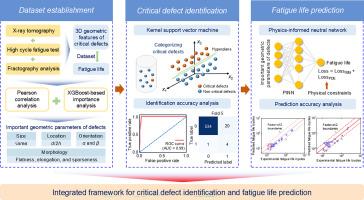具有大量内部缺陷的激光 3D 打印 AlSi10Mg 合金的临界物理学疲劳寿命预测
IF 7.1
1区 工程技术
Q1 ENGINEERING, MECHANICAL
International Journal of Mechanical Sciences
Pub Date : 2024-09-14
DOI:10.1016/j.ijmecsci.2024.109730
引用次数: 0
摘要
快速成型金属部件的高循环疲劳寿命存在明显差异,这对结构完整性提出了日益严峻的挑战。这种疲劳寿命差异的根本原因在于导致裂纹产生的关键缺陷的物理特征存在差异。为解决这一问题,本文提出了一个综合框架,利用物理信息机器学习识别关键缺陷并预测疲劳寿命,重点关注三维缺陷特征的影响。通过采用 X 射线断层扫描、高循环疲劳测试和死后试样的断裂分析,首先建立了与大量内部缺陷相关的数据集,从而将关键缺陷的空间几何特征与疲劳寿命联系起来。然后,使用核支持向量机建立关键缺陷识别模型,旨在通过评估缺陷的几何属性,从众多缺陷中识别出关键缺陷。最后,利用物理信息神经网络开发了疲劳寿命预测模型,该模型将缺陷几何形状对疲劳寿命的影响作为损失函数中的物理约束条件。综合框架表明,根据每个试样中已识别的关键缺陷预测的疲劳寿命偏差很小,平均预测值在误差带的两倍以内。这项研究有望通过连续的关键缺陷识别和疲劳寿命预测,为增材制造部件的疲劳评估提供有价值的参考。本文章由计算机程序翻译,如有差异,请以英文原文为准。

Critical physics-informed fatigue life prediction of laser 3D printed AlSi10Mg alloys with mass internal defects
The significant scatter in high cycle fatigue life of additively manufactured metallic components presents an increasing challenge to structural integrity. This fatigue life variation is radically attributed to the differences in physical features of critical defects that lead to crack initiation. To address this issue, this paper proposes an integrated framework for identifying critical defects and predicting fatigue life using physics-informed machine learning, with a focus on the impact of 3D defect features. By employing X-ray tomography, high cycle fatigue tests, and fractography analyses on post-mortem specimens, a dataset associated with mass internal defects is first built up to correlate the spatial geometric features of critical defects with fatigue life. A kernel support vector machine is then used to formulate a critical defect identification model, aimed at identifying critical defects among numerous defects by evaluating their geometric attributes. Finally, a fatigue life prediction model is developed using a physics-informed neural network, which incorporates the influence of defect geometry on fatigue life as physical constraints in the loss function. The integrated framework demonstrates that fatigue life predictions from identified critical defects in each specimen exhibit small deviations, with the average prediction falling within twice the error bands. This study is expected to provide a valuable reference for fatigue assessment of additively manufactured components through sequential critical defect identification and fatigue life prediction.
求助全文
通过发布文献求助,成功后即可免费获取论文全文。
去求助
来源期刊

International Journal of Mechanical Sciences
工程技术-工程:机械
CiteScore
12.80
自引率
17.80%
发文量
769
审稿时长
19 days
期刊介绍:
The International Journal of Mechanical Sciences (IJMS) serves as a global platform for the publication and dissemination of original research that contributes to a deeper scientific understanding of the fundamental disciplines within mechanical, civil, and material engineering.
The primary focus of IJMS is to showcase innovative and ground-breaking work that utilizes analytical and computational modeling techniques, such as Finite Element Method (FEM), Boundary Element Method (BEM), and mesh-free methods, among others. These modeling methods are applied to diverse fields including rigid-body mechanics (e.g., dynamics, vibration, stability), structural mechanics, metal forming, advanced materials (e.g., metals, composites, cellular, smart) behavior and applications, impact mechanics, strain localization, and other nonlinear effects (e.g., large deflections, plasticity, fracture).
Additionally, IJMS covers the realms of fluid mechanics (both external and internal flows), tribology, thermodynamics, and materials processing. These subjects collectively form the core of the journal's content.
In summary, IJMS provides a prestigious platform for researchers to present their original contributions, shedding light on analytical and computational modeling methods in various areas of mechanical engineering, as well as exploring the behavior and application of advanced materials, fluid mechanics, thermodynamics, and materials processing.
 求助内容:
求助内容: 应助结果提醒方式:
应助结果提醒方式:


